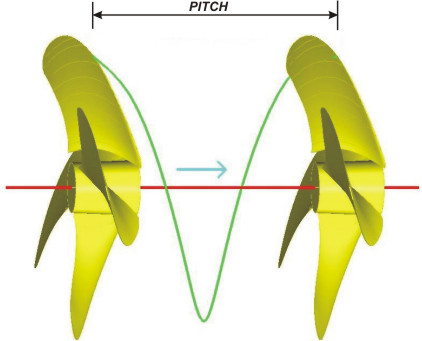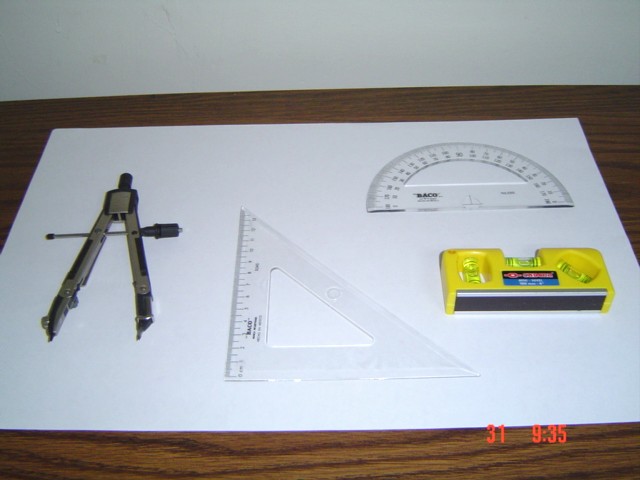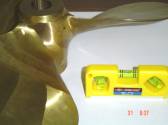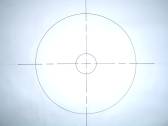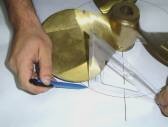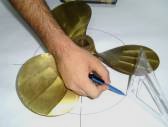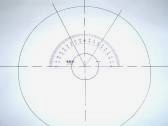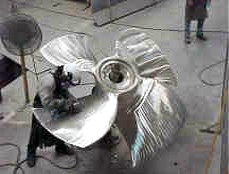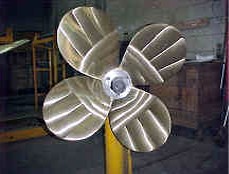The following excerpt is from the hull strength introductory chapter of "Steep Angles and Deep Dives". It provides some basic information on submarine hull strength including the definition of test depth and high yield:
Test depth is a theoretical number corresponding to the amount of area pressure that can be applied to a hull before it is violated by either distortion, warping, buckling or cracking. The pressure hull acts to prevent an equalization of pressure on both sides of the hull surface. When pressure is equal on both sides of a hull, such as is the case in a submarine's external ballast tanks, there is no need to attend to the problem of potential collapse.
Test depth can be thought of as an engineering estimate of what pressure will be required on one side of a hull to breach the hull, taking into account such factors of hull strength as hull diameter, hull thickness, framing, and intrusions. Naval engineers tend to be conservative in their estimates and the varied factors tend to render an estimate as just that, an estimate. The engineers back into the problem by first estimating the crush depth of a hull, then creating the theoretical test depth by a applying a decimal factor to the crush depth. Different national navies apply varying factors. The United States Navy has used a factor of 1.5, but this has changed many times. Of course, computers are able to make such estimates much more trust-worthy, however, the accounts described "Steep Angles and Deep Dives" are, for the most part, in hulls designed before the advent of the computer.
In the American Navy, hull designers depend on the experience of submarines to verify their estimates. Buships requires a submarine captain to immediately notify both Buships and the Chief of Naval Operations in writing when a boat under his command exceeds test depth. The captain's professional career may be jeopardized by a zealous attention to recording a dive that went wrong. Only in wartime can a captain reasonably explain the need to exceed test depth. For this reason submarines exceeding test depth sometimes fail to make note of the dive in their deck logs.
The simplest application of determining hull strength is the hull thickness. The thicker the hull metal the stronger the hull and the deeper the test depth, assuming all other factors are constant. Prior to the Balao class U.S. submarine, hulls were built of mild steel (MS) which had a maximum tensile strength of 60,000 pounds per square inch and a yield strength of 45,000 psi with 23 percent elongation. The thickness of hull plating until about 1943 was specified in terms of the weight of a square foot of plate rather than the actual thickness, and this was gradually increased from 20 pound plate (approximately one half inch) to twenty seven and a half pounds per square inch in the Salmon (SS-182).
Another change in the Balao class was the change in material used for hulls. High tensile steel was a chromium-vanadium alloy with a maximum tensile strength of 50,000 psi with 20 percent elongation. When the composition was changed to titanium-manganese alloy, because of wartime shortages, the strength dropped to 45,000 psi. The Salmon's hull was about seven eighths of an inch thick giving her a test depth of 250 feet. Conning tower shells were thicker as protection against surface guns.
The thick-skinned boats came along in 1942 with a test depth of 412 feet. These boats had the same seven eighths inch thick hull as Salmon, but the quality of hull steel ie., high tensile strength steel had significantly improved. The crush depth of these boats was estimated to be around 450 feet. Fleet type submarines built during the Second World War were to last through much of the cold war. These boats have careers that have lasted over fifty years with many still being used by foreign navies.
After the war the Navy built several fast attack submarines. These had hulls about an inch and a half thick. They had a test depth of 700 feet. The same hull thickness and quality of steel was used on the early nuclear submarines.
A modern nuclear powered submarine normally has a test depth of over 2000 feet. This huge increase in operational depth came about from increasing the thickness of a hull, from strides in improving the quality of steel, from improvements in the manufacturing process and in hull framing.
Steel is an alloy made up of several metals other than iron. These may include chromium, nickel, manganese, titanium and a host of others. Metallurgy is the science of combining these elements to produce an iron metal that meets a specific need, in this case a hull which is resistant to sea pressure. During the Second World War Krupp of Germany and others used advanced techniques to produce hull plating of unusually high quality. America inherited some of the formulae and steel mills benefited by the German experience.
The key to producing metal hulls suitable to deep diving submarines is the quality of yield strength in combination with compression strength. Accurately controlled element content and relatively high percentages of alloy additives produces strength. The compression strength curve is relatively flat until it reaches a point where the molecules can no longer bind, then the metal fails by cracking and splitting. On the other hand it is possible to produce a metal hull that has the quality of bending rather than rupturing. It yields under pressure where its elasticity, (elongation) gradually succumbs to increasing pressure. The trick for the metallurgist is to strike a compromise and to use the correct ratio of alloy elements to gain a hull plate that resists pressure to the maximum through high compression strength, but yields enough to forestall the rupturing of the metal.
Steel strength is often measured by tensile strength. In this test the metal is pulled on both ends until it parts. Tensile strength is related to compression strength even though the tests are opposite, one pulling and the other pushing. For this reason submarine steel strength is often measured in tensile strength, not withstanding the nature of sea pressure as a compression force.
American submarines such as the Seawolf and Virginia use HY (high yield) 100 metals. These designators attend to the elements used in the submarine hull's alloy where essentially the higher the number the more resilient and resistant the metal is to pressure.
The combination of elements to produce an alloy with great strength is only half the story of producing submarine hulls. The second factor in the manufacturing process is the tempering of the steel and shaping of the plates into a final form. Once again, the basic concept is that a slow-cooling steel tends to be resilient and a quick cooling steel tends to be brittle. Metallurgists in the middle ages learned this early on and after shaping a red hot sword on an anvil plunged it into water. This gave the sword a fine cutting edge resistant to chipping and dulling. The down side was that when struck by another sword it tended to shatter rather than yield. Thus, a submarine's hull plating is cooled at a specific rate designed to produce the best combination of stress and yield factors.
The shaping of the plate in the factory is accomplished with huge hydraulic rollers. The shaping process is also a compromise. Some alloys are cold rolled. This is the optimum in terms of preserving the alloy's strength in the shaping process, however, as the thickness of the plate increases the effect of the rolling becomes less and less. The modern mill now uses computers to cold roll submarine hull plates. Each pass through the rollers bends the steel a small amount until after many ( in some cases hundreds) of such passes through the rollers the plate conforms to the correct hull curvature.
In determining the diameter of the pressure hull the engineer takes into account the metal thickness that will be required to meet a given strength level. The less the diameter the thinner the metal can be. The size of machinery largely determines the diameters of submarines. As the design of the submarine progresses the diameter of the hull inevitably increases. (Modern Trident missile submarines have a forty three foot diameter pressure hull) This necessitates a thicker hull where the alloys used and the shaping process are constant. Once again, the hull design process is one of compromise where interplaying factors are balanced against one another until a final design with an estimate of test depth is reached.
The curved plates of metal to make up the submarine's hull are further strengthened by frames. Lateral framing was known to the Vikings, although they started with a hull shape and only after the strakes had been laid did they imbed the frames into the preformed hull. Submarine hull strength is in large part a function of frame strength and spacing. Cross sections of frames are normally "T" shaped and can be within the pressure hull, on the exterior of the pressure hull, or both. The externally braced hull was the standard in submarine design, because piping and conduit cannot penetrate frames without compromising strength. With modern welding techniques it has been possible to grip the hull plate to the frame with such force that external framing is successful.
The distance between frames is crucial to determining test depth since this distance is where a compressed hull will yield or fail. The distance is a design function taking into account the factors described in this section.
The cylinder is the optimal shape for a submarine hull. A sphere is better still, however, the shape of a sphere does not accommodate a moving vessel through water. Only in experimental and exploration vehicles is the spherical hull shape used. A submarine is in essence, a long cylinder, made up of many sections welded together.
The tapered ends of the fleet type submarine (forward torpedo room and after torpedo room) called for innovation since the cylindrical form had to be compromised. These compartments were flattened for hydrodynamic reasons. Fleet type boats had exterior framing, however, in these end compartments the frames were interior as well as exterior. The deviation from circularity although small, produced a bending moment putting the shell plating under compression and the face plate of the frame under tension. Thus, the mass-produced fleet type boats had framing partly on the inside and partly on the outside of the pressure hull.
Three dimensional curvature for modern hemispherical bows require conical shaping, and tapered hull plating that in turn requires extensive welding.
The welding of the many plates and commensurate framing necessitates the greatest care. The weld seam must have the same strength as the abutting hull plates. This means that if welding is accomplished by hand the welder must be of the highest technical competence. Although a submarine may be similar to others in its class each is essentially hand built. Automation is limited, but computerization is extensive.
Hull butting is exact. Each cylindrical hull section must precisely match the adjoining section. Each cylindrical section has its edges ground to an approximate forty five degree knife edge. When two sections are mated the two edges form a trough. Actually, there are two troughs, one on the inside of the cylinder and the other on the outside. The welder (or machine) places the first bead at the deepest point of the trough. The next weld layer is placed on top of the deeper layer. As the process continues and the wedge shaped trough widens, more and more beads are placed side by side to fill the trough. Many hundreds of beads are required to bring the level of beading to the surface of the abutting hull sections. It is a long and tedious job and quality inspections are constant.
Unfortunately, a perfect cylindrical hull with precise welding and engineered frame spacing must be punctured to allow various pipes, coaxial cables and rotating shafts access to the exterior of the hull. Wherever such a hull opening occurs the hull must be reinforced by building up the thickness of the surrounding area. The larger the opening (such as for hatches) the stronger must be the build-up. Even when every effort is made to compensate for the loss of strength from a hull opening the point of violation will be the point of failure when the hull exceeds test depth.
Time destroys the hull from several directions. The metal itself fatigues over time. Additionally, the sea takes its toll with corrosion eating at the metal. Hull modifications requiring welding, heat the hull and thereby reduce the effectiveness of the initial tempering. Nicks, gouges and scrapes collectively take their toll.
The Fleet Type boat designed and built during the Second World War were subsequently equipped with snorkels and modified into Guppies. These were often given to other nations under various alliances. Many of these boats are still operating as naval units in foreign navies. They are only now being replaced by more recently built boats.

 The Shipping Corporation of India Ltd (SCI) was formed on 2nd October 1961. The present authorised capital of the Company is Rs. 450 crore and paid up capital is Rs 282.30 crore. The status of SCI has been changed from a private limited company to Public limited from 18 September 1992. The SCI was conferred 'Mini Ratna' status by the Government of India on 24 Feburary 2000. At present, the Government is holding 80.12 per cent of share capital and the balance is held by financial institutions, public and others (NRIs, Corporate Bodies, etc.). SCI signed Memorandum of Understanding with the Ministry of Shipping, Road Transport & Highways, Government of India on 27 March 2008.
The Shipping Corporation of India Ltd (SCI) was formed on 2nd October 1961. The present authorised capital of the Company is Rs. 450 crore and paid up capital is Rs 282.30 crore. The status of SCI has been changed from a private limited company to Public limited from 18 September 1992. The SCI was conferred 'Mini Ratna' status by the Government of India on 24 Feburary 2000. At present, the Government is holding 80.12 per cent of share capital and the balance is held by financial institutions, public and others (NRIs, Corporate Bodies, etc.). SCI signed Memorandum of Understanding with the Ministry of Shipping, Road Transport & Highways, Government of India on 27 March 2008.  Situated in the Western coast of India in the city Cochin, State of Kerla, Cochin Shipyard is the largest shipyard in the country. Incorporated in the year 1972, Cochin Shipyard can build ships upto 1,10,000 DWT and repair ships upto 1,25,000 DWT. The year has built varied types of ships including tankers, bulk carriers, ports crafts, offshore vessels and passenger vessels. The orders executed by CSL in recent past include carriers for M/s Clipper Group, Bahamas, firefighting tugs for M/s ATCO, Saudi Arabia and Platform Supply Vessels for M/s Deep Sea Supplies, Norway.
Situated in the Western coast of India in the city Cochin, State of Kerla, Cochin Shipyard is the largest shipyard in the country. Incorporated in the year 1972, Cochin Shipyard can build ships upto 1,10,000 DWT and repair ships upto 1,25,000 DWT. The year has built varied types of ships including tankers, bulk carriers, ports crafts, offshore vessels and passenger vessels. The orders executed by CSL in recent past include carriers for M/s Clipper Group, Bahamas, firefighting tugs for M/s ATCO, Saudi Arabia and Platform Supply Vessels for M/s Deep Sea Supplies, Norway. The Garden Reach Shipbuilders & Engineers Limited was incorporated as a joint stock company in 1934, under the name M/s Garden Reach Worskhop Limited (GRW). The Government of India acquired the company in 1960. It was renamed as "Garden Reach Shipbuilders & Engineers Limited (GRSE)" on 01 January 1977.
The Garden Reach Shipbuilders & Engineers Limited was incorporated as a joint stock company in 1934, under the name M/s Garden Reach Worskhop Limited (GRW). The Government of India acquired the company in 1960. It was renamed as "Garden Reach Shipbuilders & Engineers Limited (GRSE)" on 01 January 1977. Hindustan Shipyard Limited (HSL), Visakhapatnam as set up in 1941 in the private sector and was taken over by the Government in 1952. In 1962, the shipyard became a central public sector enterprise. The shipbuilding capacity of the yard is 3.5 pioneer class vessels of 21,500 DWT each. The maximum size of vessel that could be built is 50,000 DWT.
Hindustan Shipyard Limited (HSL), Visakhapatnam as set up in 1941 in the private sector and was taken over by the Government in 1952. In 1962, the shipyard became a central public sector enterprise. The shipbuilding capacity of the yard is 3.5 pioneer class vessels of 21,500 DWT each. The maximum size of vessel that could be built is 50,000 DWT. Hooghly Dock and Port Engineers Limited (HDPEL), Kolkata became a Central Publi Sector Undertaking in 1984. The company has two working units in Howrah District of West Bengal, one at Salkia and another at Nazirgunge. The installed capacity in shipbuilding is 1,100 tonnes per annum and in ship repairs 125 ships per annum. Apart from a dry dock and a jetty, it has six shipways. The yard is capable of constructing various types of ships (including passenger ships) and other vessels such as dredgers, tugs, floating dry docks, fishing trawlers, supply-cum-support vessels, multi-purpose harbour vessels, lighhouse tender vessels, barges, mooring launches, etc., and undertaking repairs of different types of vessels.
Hooghly Dock and Port Engineers Limited (HDPEL), Kolkata became a Central Publi Sector Undertaking in 1984. The company has two working units in Howrah District of West Bengal, one at Salkia and another at Nazirgunge. The installed capacity in shipbuilding is 1,100 tonnes per annum and in ship repairs 125 ships per annum. Apart from a dry dock and a jetty, it has six shipways. The yard is capable of constructing various types of ships (including passenger ships) and other vessels such as dredgers, tugs, floating dry docks, fishing trawlers, supply-cum-support vessels, multi-purpose harbour vessels, lighhouse tender vessels, barges, mooring launches, etc., and undertaking repairs of different types of vessels. 